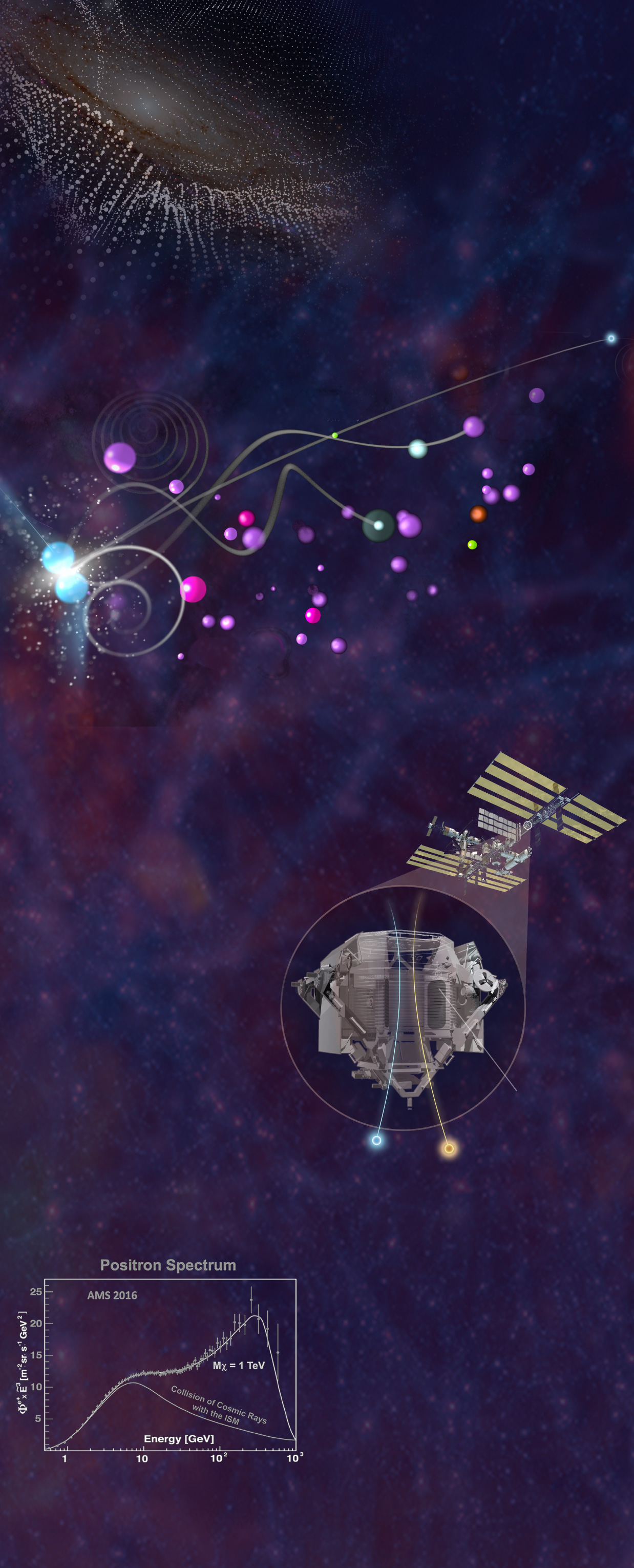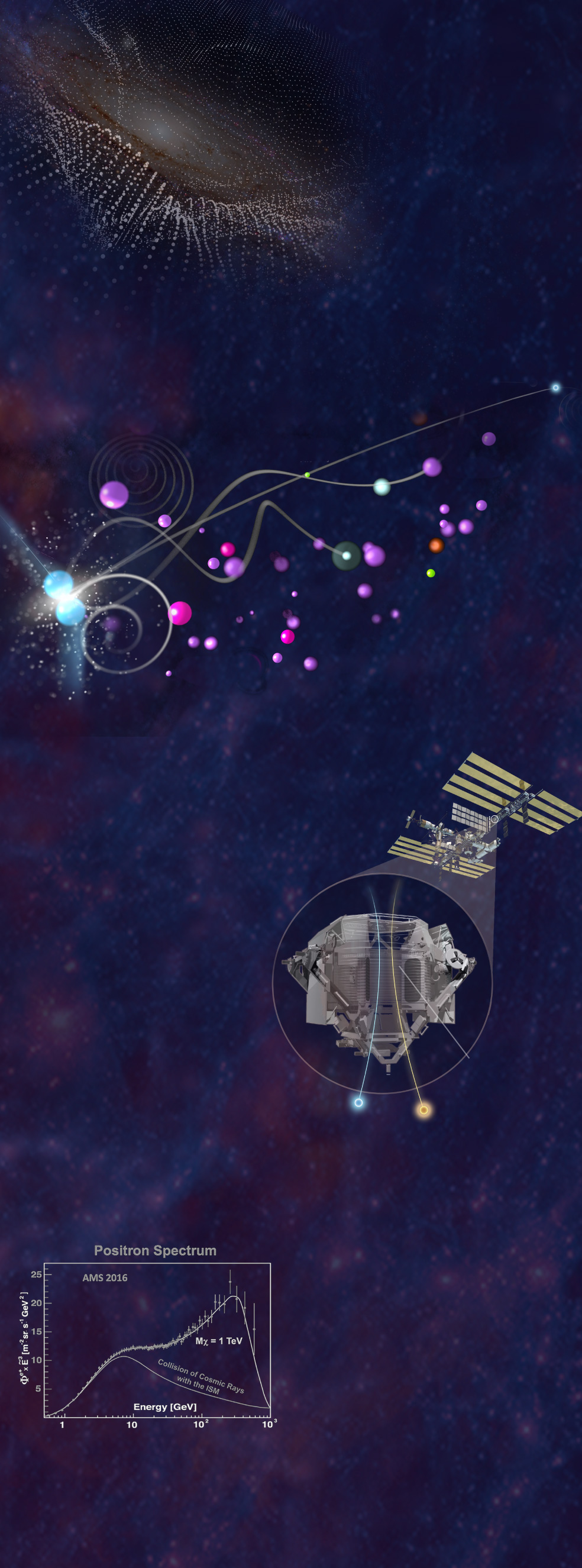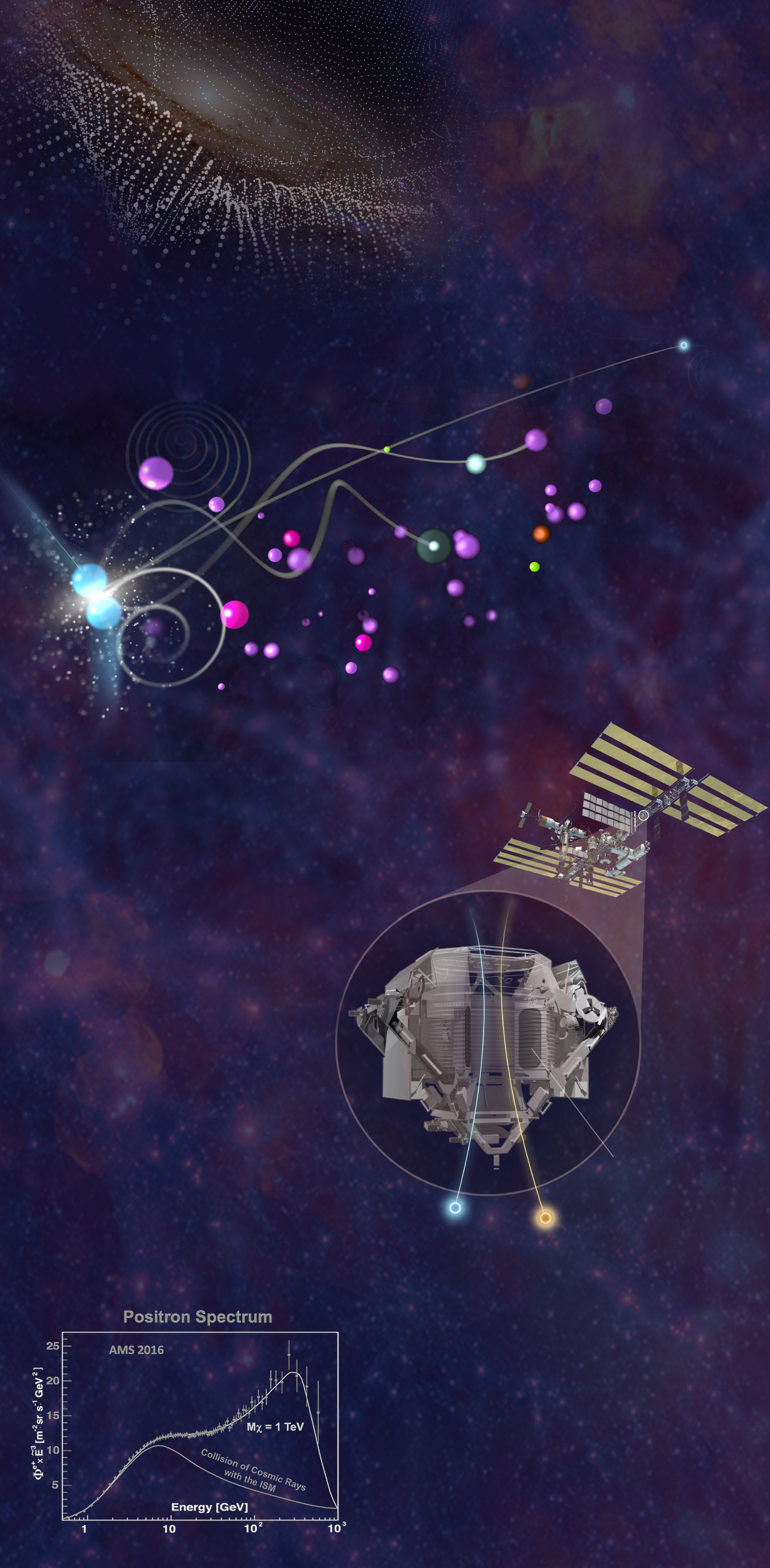
WHAT IS
DARK MATTER?
Galaxies are spinning too fast. At least, if you consider the amount of matter in them – there isn't enough gravity to hold them together. They should contain about five times more matter to produce that gravitational force. This is why scientists believe there is "dark" matter floating out in these galaxies, helping to hold the stars together.
DARK MATTER IS
ITS OWN ANTIMATTER
Dark matter particles are their own antiparticles. If they bump into one another, they'll revert the energy, a process called annihilation. This energy can then become any kind of particle-antiparticle pair. Because antiparticles are rare, they can be measured to infer the presence of dark matter.
LOW-ENERGY
PHOTONS
ANTIPROTONS
GAMMA RAYS
DARK MATTER
PARTICLES
PROTONS
ELECTRONS
POSITRONS
PARTICLES OF
FAMILIAR MATTER
NEUTRINOS
MEASURING ANTIMATTER
Ting and his colleagues are looking for antimatter, – in order to get hints about dark matter – through a particle physics detector on the International Space Station.
The central component of the detector, called the Alpha Magnetic Spectrometer, is a large magnet. When particles pass through this detector, positively charged particles curve one way and negatively charged particles curve the other way. The scientists combine this information with a measure of the mass to determine a particle ID. Some are regular matter, such as electrons. Others are the corresponding antimatter, such as positrons.
A certain amount of antimatter is expected from cosmic ray collisions (particles that are catapulted out of exploding stars), but if dark matter particles are running into one another, we should see more.
INTERNATIONAL SPACE STATION
ALPHA MAGNETIC SPECTROMETER
Magnet directs the path of cosmic particles through the detectors
Path of matter particles
Path of antimatter particles
SO HAS THE DETECTOR FOUND DARK MATTER?
It does boast a suspicious trend in the positron spectrum – or how the frequency of positron detections changes at higher and higher momentum measurements. The curve resembles what you'd see if there were dark matter particles with masses of about 1 teraelectronvolt – roughly 1000 times more massive than a proton. But it doesn't qualify as a smoking gun – this pattern could also come from proposed physics related to exotic post-supernova stellar remnants known as pulsars. Still, by the end of the experiment in 2024, Ting is optimistic that we could have an answer.

WHAT IS
DARK MATTER?
Galaxies are spinning too fast. At least, if you consider the amount of matter in them – there isn't enough gravity to hold them together. They should contain about five times more matter to produce that gravitational force. This is why scientists believe there is "dark" matter floating out in these galaxies, helping to hold the stars together.
DARK MATTER IS
ITS OWN ANTIMATTER
Dark matter particles are their own antiparticles. If they bump into one another, they'll revert the energy, a process called annihilation. This energy can then become any kind of particle-antiparticle pair. Because antiparticles are rare, they can be measured to infer the presence of dark matter.
PROTONS
ANTIPROTONS
ELECTRONS
POSITRONS
NEUTRINOS
LOW-ENERGY
PHOTONS
GAMMA RAYS
PARTICLES OF
FAMILIAR MATTER
DARK MATTER
PARTICLES
MEASURING ANTIMATTER
Ting and his colleagues are looking for antimatter, – in order to get hints about dark matter – through a particle physics detector on the International Space Station.
The central component of the detector, called the Alpha Magnetic Spectrometer, is a large magnet. When particles pass through this detector, positively charged particles curve one way and negatively charged particles curve the other way. The scientists combine this information with a measure of the mass to determine a particle ID. Some are regular matter, such as electrons. Others are the corresponding antimatter, such as positrons.
A certain amount of antimatter is expected from cosmic ray collisions (particles that are catapulted out of exploding stars), but if dark matter particles are running into one another, we should see more.
INTERNATIONAL SPACE STATION
ALPHA MAGNETIC SPECTROMETER
Magnet directs the path of cosmic particles through the detectors
Path of matter particles
Path of antimatter particles
SO HAS THE DETECTOR FOUND DARK MATTER?
It does boast a suspicious trend in the positron spectrum – or how the frequency of positron detections changes at higher and higher momentum measurements. The curve resembles what you'd see if there were dark matter particles with masses of about 1 teraelectronvolt – roughly 1000 times more massive than a proton. But it doesn't qualify as a smoking gun – this pattern could also come from proposed physics related to exotic post-supernova stellar remnants known as pulsars. Still, by the end of the experiment in 2024, Ting is optimistic that we could have an answer.

WHAT IS
DARK MATTER?
Galaxies are spinning too fast. At least, if you consider the amount of matter in them – there isn't enough gravity to hold them together. They should contain about five times more matter to produce that gravitational force. This is why scientists believe there is "dark" matter floating out in these galaxies, helping to hold the stars together.
DARK MATTER IS
ITS OWN ANTIMATTER
Dark matter particles are their own antiparticles. If they bump into one another, they'll revert the energy, a process called annihilation. This energy can then become any kind of particle-antiparticle pair. Because antiparticles are rare, they can be measured to infer the presence of dark matter.
LOW-ENERGY
PHOTONS
ANTIPROTONS
GAMMA RAYS
DARK MATTER
PARTICLES
PROTONS
ELECTRONS
POSITRONS
PARTICLES OF
FAMILIAR MATTER
NEUTRINOS
MEASURING ANTIMATTER
Ting and his colleagues are looking for antimatter, – in order to get hints about dark matter – through a particle physics detector on the International Space Station.
The central component of the detector, called the Alpha Magnetic Spectrometer, is a large magnet. When particles pass through this detector, positively charged particles curve one way and negatively charged particles curve the other way. The scientists combine this information with a measure of the mass to determine a particle ID. Some are regular matter, such as electrons. Others are the corresponding antimatter, such as positrons.
A certain amount of antimatter is expected from cosmic ray collisions (particles that are catapulted out of exploding stars), but if dark matter particles are running into one another, we should see more.
INTERNATIONAL SPACE STATION
ALPHA MAGNETIC SPECTROMETER
Magnet directs the path of cosmic particles through the detectors
Path of matter particles
Path of antimatter particles
SO HAS THE DETECTOR FOUND DARK MATTER?
It does boast a suspicious trend in the positron spectrum – or how the frequency of positron detections changes at higher and higher momentum measurements. The curve resembles what you'd see if there were dark matter particles with masses of about 1 teraelectronvolt – roughly 1000 times more massive than a proton. But it doesn't qualify as a smoking gun – this pattern could also come from proposed physics related to exotic post-supernova stellar remnants known as pulsars. Still, by the end of the experiment in 2024, Ting is optimistic that we could have an answer.

WHAT IS
DARK MATTER?
Galaxies are spinning too fast. At least, if you consider the amount of matter in them – there isn't enough gravity to hold them together. They should contain about five times more matter to produce that gravitational force. This is why scientists believe there is "dark" matter floating out in these galaxies, helping to hold the stars together.
DARK MATTER IS
ITS OWN ANTIMATTER
Dark matter particles are their own antiparticles. If they bump into one another, they'll revert the energy, a process called annihilation. This energy can then become any kind of particle-antiparticle pair. Because antiparticles are rare, they can be measured to infer the presence of dark matter.
LOW-ENERGY
PHOTONS
ANTIPROTONS
GAMMA RAYS
DARK MATTER
PARTICLES
PROTONS
ELECTRONS
POSITRONS
PARTICLES OF
FAMILIAR MATTER
NEUTRINOS
MEASURING ANTIMATTER
Ting and his colleagues are looking for antimatter, – in order to get hints about dark matter – through a particle physics detector on the International Space Station.
The central component of the detector, called the Alpha Magnetic Spectrometer, is a large magnet. When particles pass through this detector, positively charged particles curve one way and negatively charged particles curve the other way. The scientists combine this information with a measure of the mass to determine a particle ID. Some are regular matter, such as electrons. Others are the corresponding antimatter, such as positrons.
A certain amount of antimatter is expected from cosmic ray collisions (particles that are catapulted out of exploding stars), but if dark matter particles are running into one another, we should see more.
INTERNATIONAL SPACE STATION
ALPHA MAGNETIC SPECTROMETER
Magnet directs the path of cosmic particles through the detectors
Path of matter particles
Path of antimatter particles
SO HAS THE DETECTOR FOUND DARK MATTER?
It does boast a suspicious trend in the positron spectrum – or how the frequency of positron detections changes at higher and higher momentum measurements. The curve resembles what you'd see if there were dark matter particles with masses of about 1 teraelectronvolt – roughly 1000 times more massive than a proton. But it doesn't qualify as a smoking gun – this pattern could also come from proposed physics related to exotic post-supernova stellar remnants known as pulsars. Still, by the end of the experiment in 2024, Ting is optimistic that we could have an answer.